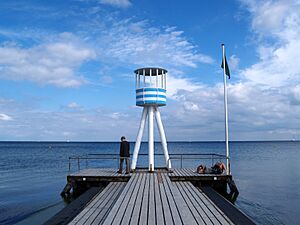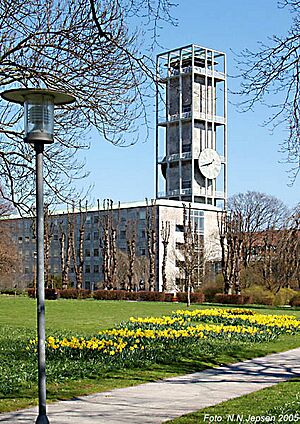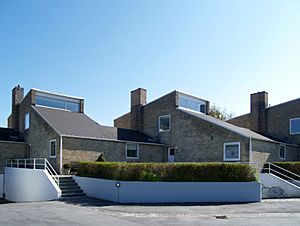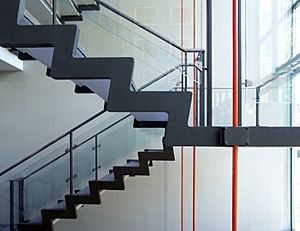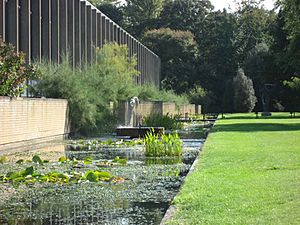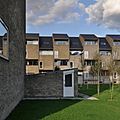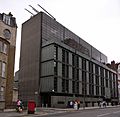Arne Jacobsen facts for kids
Quick facts for kids
Arne Emil Jacobsen
|
|
|---|---|
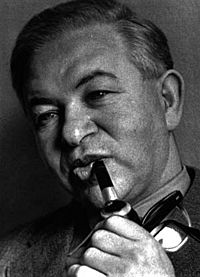 |
|
| Born | 11 February 1902 |
| Died | 24 March 1971 (aged 69) |
| Nationality | Danish |
| Occupation | Architect |
| Awards | C. F. Hansen Medal (1955) |
| Buildings | Bellevue Theatre SAS Royal Hotel Aarhus City Hall St Catherine's College Danmarks Nationalbank |
Arne Emil Jacobsen (born February 11, 1902 – died March 24, 1971) was a famous Danish architect and furniture designer. He is known for his work in a style called functionalism. This means he designed buildings and furniture that were useful and simple. He became famous worldwide for his well-designed chairs.
Contents
Biography
Early life and education
Arne Jacobsen was born in Copenhagen, Denmark, on February 11, 1902. His father sold things like safety pins. His mother worked at a bank and loved flowers. Arne first wanted to be a painter. But his mother thought architecture would be a more stable job.
After working as a mason (someone who builds with stone), Arne went to the Architecture School at the Royal Danish Academy of Fine Arts. He studied there from 1924 to 1927. His teachers were leading architects of the time.
In 1925, while still a student, Arne went to an art fair in Paris. He won a silver medal for a chair design. He was very impressed by the modern buildings he saw there. He also traveled to Germany. There, he saw the simple, clear designs of architects like Mies van der Rohe and Walter Gropius. Their ideas influenced his early work.
In 1929, Arne Jacobsen and Flemming Lassen won a contest. They designed the "House of the Future." It was built for an exhibition in Copenhagen. This house was very modern. It had a spiral shape and a flat roof made of glass and concrete. It even had a private garage, a boathouse, and a helicopter pad! Other cool features included windows that rolled down like car windows and a tube for mail. This project made Arne Jacobsen known as a very modern architect.
Pre-World War II career
The year after designing the "House of the Future," Arne Jacobsen opened his own office. He designed the Rothenborg House, which was very functional. He planned every small detail, which became a trademark of his work.
Soon after, he won a competition to design a seaside resort in Klampenborg, north of Copenhagen. This project made him very famous in Denmark. It showed him as a leader of the International Modern Style. In 1932, the Bellevue Sea Bath opened. Arne designed everything for it. This included the blue-striped lifeguard towers, kiosks, and even the staff uniforms.
In 1934, he built the Bellavista homes. These were made of concrete, steel, and glass. They had smooth surfaces and open spaces, without any extra decorations. In 1937, the Bellevue Theatre was finished. It had a roof that could open for outdoor shows. These early buildings showed the influence of the simple, white buildings he saw in Germany. People called these projects "The dream of the modern lifestyle."
Arne Jacobsen also designed the Stelling House in Copenhagen. Many people protested this building because it looked too modern for the historic area. One newspaper even said he should be "banned from architecture for life"!
Later, he and Erik Møller won a competition to design Århus City Hall. This design was also controversial. People thought it was too modern and not grand enough. So, Arne had to add a tower and marble to the building. Still, it is now seen as one of his most important works.
World War II exile and return
During World War II, it was hard to get building materials. Also, because of Nazi laws against Jewish people, Arne Jacobsen, who was Jewish, had to leave his office in 1943. He fled Denmark to escape being sent to concentration camps. With help from the Danish resistance, he rowed a small boat to Sweden. He stayed there for two years. During this time, he mostly designed fabrics and wallpaper.
When the war ended in 1945, Jacobsen returned to Denmark. The country needed many new homes and public buildings. These had to be simple and quick to build.
After a few years, Arne's career picked up again. He started to experiment more with projects like the Allehusene complex (1952) and his Søholm terraced houses (1955). He even lived in one of the Søholm houses until he died.
Rødovre Town Hall, built from 1952 to 1956, shows how well Arne used different materials. These included sandstone, glass, and stainless steel. It is also famous for its central staircase. This staircase hangs from the roof on bright orange-red steel rods.
The Munkegaard School was built with separate buildings connected by glass hallways. These were arranged around small courtyards. This school became very famous around the world and helped his international reputation grow.
Large commissions
From 1956 to 1960, Arne Jacobsen designed the SAS Royal Hotel. This was called "the world's first designer hotel." He designed everything for it. This included the building itself, the furniture, and even the ashtrays and airport buses.
These big projects started to get attention from other countries. Because of Rødovre Town Hall, he was invited to design buildings in Germany.
A group from Oxford University visited the SAS Hotel and the Munkegård School. They were looking for an architect for St Catherine's College. They quickly decided Arne Jacobsen was the right person. Again, he designed everything, even the garden and the types of fish for the pond. The dining hall has a special floor made of Cumbrian slate.
Incomplete works
Arne Jacobsen passed away suddenly in 1971. He had many big projects still being built. These included new town halls in Germany, the Danish National Bank, and the Royal Danish Embassy in London. His former employees finished these projects.
Furniture and product design


Today, Arne Jacobsen is most famous for his furniture designs. But he always thought of himself as an architect first. He didn't even like the word "designer."
He started designing products because he believed in designing everything for a project. Many of his famous designs were first made for his buildings. One of his first furniture pieces was the Paris lounge chair from 1929.
He worked closely with the furniture company Fritz Hansen starting in 1934. His lamps were made with Louis Poulsen. Even though his chair won an award in 1925, his interest in furniture design really grew in the 1950s.
He was inspired by the bent plywood designs of Charles and Ray Eames. He also liked the idea that every design, "from the spoon to the city," was equally important. This fit well with his own beliefs.

In 1951, he created the Ant chair for a factory. In 1955, came the Seven Series chairs. Both were light, small, and easy to stack. This made them perfect for modern needs. Two other popular chairs, the Egg and the Swan, were designed for the SAS Royal Hotel in 1958.
He also designed items for Stelton, a company started by his foster son. These include the classic Cylinda Line stainless steel cocktail set and tableware.
Another design is a line of faucets and accessories for bathrooms and kitchens. He created these after winning a competition in 1961 for his design of the National Bank of Denmark. This classic design is still made today by a Danish company called Vola.
Style and legacy
Arne Jacobsen is known for his great sense of proportion. He believed this was one of the most important parts of his work. He once said that good proportion is what makes beautiful ancient Egyptian temples and famous Renaissance buildings.
His work is seen as a very important part of modern design. It added a "humane element" to the modern movement, making it more friendly and approachable.
Selected works
Architecture
- Bellevue Beach, Klampenborg, Denmark (1932)
- Bellavista residential complex, Klampenborg, Copenhagen (1931–34)
- Bellevue Theatre and restaurant, Klampenborg (1935–36)
- Skovshoved Petrol Station, Skovshoved, Copenhagen (1936)
- Stelling House, 6 Gammeltorv, Copenhagen (1934–37)
- Søllerød Town Hall (with Flemming Lassen), Søllerød, Copenhagen (1938–42)
- Århus City Hall (with Erik Møller), Århus (1939–42)
- Søholm I (1946–50), II and III terraced houses, Klampenborg
- Rødovre Town Hall, Rødovre, Denmark (1952–56)
- Alléhusene housing, Gentofte, Copenhagen (1949–1953)
- Glostrup Town Hall, Glostrup, Copenhagen (1958)
- Munkegaard School, Copenhagen (1957)
- SAS Royal Hotel, Copenhagen (1958–60)
- Toms Chocolate Factory, Ballerup, Copenhagen (1961)
- National Bank of Denmark, Copenhagen (1965–70)
- Landskrona Sports-Hall, Landskrona, Sweden (1965)
- St Catherine's College, Oxford, UK (1964–66)
- Mainz City Hall, Mainz, Germany (1966–73)
- Castrop-Rauxel Town Hall and Forum, Castrop-Rauxel, Germany (1966–76)
- Christianeum School, Hamburg, Germany (1970–71)
- HEW Vattenfall Europe, Hamburg, Germany (1970)
- Royal Danish Embassy, London, UK (1976–77)
Furniture and product design
- Paris Lounge Chair (1929)
- Charlottenborg Lounge Chair / A.J 237 (1936)
- Charlottenborg Sofa and Charlottenborg Coffee Table (1937)
- Ant chair (1952)
- Dot Stool Model 3170 (1954)
- Tongue chair (1955)
- Series 7 chairs
- Swan chair (1958)
- Egg chair (1958)
- Pot chair (1959)
- Giraffe chair (1959)
- Cylinda Line tableware
- Flatware cutlery (1957)
- VOLA (1968)
- Dot Stool Model M3170 (1969)
- Drop chair
In culture and media
- Arne Jacobsen's No. 7 chair became famous in a photo of Christine Keeler in 1963. The photographer just happened to use a copy of Jacobsen's chair. Since then, many similar photos have used this chair.
- The Seven chair has also appeared on the TV show EastEnders.
- Jacobsen's flatware (cutlery) was used in the movie 2001: A Space Odyssey. It was chosen because it looked "futuristic."
- Arne Jacobsen's grandson, Tobias Jacobsen, is also a furniture designer.
Awards and recognition
- 1955 C. F. Hansen Medal
- 1957 Grand prix, Milan XI Triennale, Italy, for Grand Prix chair
- 1961 Honorary DLitt, Oxford University
- 1962 Prince Eugen Medal for architecture
- 1967 ID-prize, Danish Society of Industrial Design, for Cylinde
- 1968 International Design Award, American Institute of Interior Designers, US, for Cylinde
See Also
 In Spanish: Arne Jacobsen para niños
In Spanish: Arne Jacobsen para niños
- Architecture of Denmark
- Danish design
- Danish modern
- Dissing+Weitling
Images for kids


